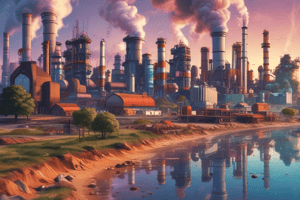Podcast
Questions and Answers
Which of the following best describes a 'contaminant' as defined in the content?
Which of the following best describes a 'contaminant' as defined in the content?
- Any substance or factor that is not originally present in the environment, appears temporarily, and causes harm. (correct)
- A substance that is permanently present in the environment and always harmful.
- Any substance or factor that causes temporary harm in the environment.
- A substance that enhances the natural composition of the environment.
What is the primary distinction between a 'pollutant' and a 'contaminant' according to the content?
What is the primary distinction between a 'pollutant' and a 'contaminant' according to the content?
- Pollutants are always temporary, while contaminants are always permanent.
- Pollutants are always naturally occurring, while contaminants are synthetic.
- Pollutants have a long-term presence and impact, while contaminants are temporary. (correct)
- Pollutants are always in large quantities, while contaminants are in small quantities.
How do seasonal winds carrying pollutants affect the environment?
How do seasonal winds carrying pollutants affect the environment?
- They have no impact on environmental pollution.
- They permanently alter the chemical composition of the atmosphere.
- They help in diluting the concentration of pollutants in the air.
- They introduce temporary contaminants that cause harm. (correct)
Which of the following scenarios represents a case of permanent pollution?
Which of the following scenarios represents a case of permanent pollution?
What is 'eutrophication,' as the content describes pollution by nutrients?
What is 'eutrophication,' as the content describes pollution by nutrients?
Which of the following is mentioned as a solution to nutrient pollution?
Which of the following is mentioned as a solution to nutrient pollution?
How do sediments contribute to environmental pollution?
How do sediments contribute to environmental pollution?
How does thermal pollution primarily affect aquatic ecosystems?
How does thermal pollution primarily affect aquatic ecosystems?
Which activity is least likely to lead to thermal pollution in water bodies?
Which activity is least likely to lead to thermal pollution in water bodies?
What is one of the direct consequences of temperature shock in aquatic environments, as related to thermal pollution?
What is one of the direct consequences of temperature shock in aquatic environments, as related to thermal pollution?
Flashcards
Pollutant
Pollutant
Any substance present in the environment that alters its natural composition and has harmful effects on environmental receptors such as humans, plants, animals, water, soil, or air.
Contaminant
Contaminant
Any substance not normally present in the environment that temporarily enters it and causes harm.
Nutrient Pollution
Nutrient Pollution
Comes from fertilizers, sewage, and fish farms, causing eutrophication (excessive nutrient enrichment) in water bodies.
Pollution by Sediments
Pollution by Sediments
Signup and view all the flashcards
Thermal Pollution
Thermal Pollution
Signup and view all the flashcards
Natural Pollution
Natural Pollution
Signup and view all the flashcards
Source
Source
Signup and view all the flashcards
Receptor
Receptor
Signup and view all the flashcards
Incubator
Incubator
Signup and view all the flashcards
The way
The way
Signup and view all the flashcards
Study Notes
- Lecture notes cover pollutants and types of pollution.
Pollutants
- Any substance or matter present in the environment that causes a change in its natural composition and has adverse effects on environmental receptors such as humans, plants, animals, water, soil, and air.
Contaminants (Temporary Pollutants)
- Any substance or matter that is not originally present in the environment but temporarily enters it and causes damage to the environment.
- Examples include:
- Smoke from burning waste or crop residues during harvest season.
- Dust resulting from seasonal winds carrying soil.
- Chlorine gas from a tank explosion on the road or gas leak from a factory, and unpleasant odors.
- Emission of pleasant odors from some factory products.
Permanent Pollutants
- Any substance or matter present in the environment in small quantities that has continuous adverse effects on environmental receptors.
- Examples include:
- Substances produced by factories.
- Sanitary wastewater.
- Pesticides used in agriculture.
- Lead from car exhaust on roads continuously throughout the day.
- Waste resulting from metal and mining industries.
- Waste present in sanitary wastewater permanently.
General Characteristics of Pollutants
- Source: The place where the pollutant originates.
- Receptor: The organism or component in the environment that is affected by the pollutant's effects.
- Incubator: The container or sink where the pollutant interacts and is retained in the environment.
- Path: The route through which the pollutant moves in the environment.
- Threshold Value: The minimum amount of a pollutant that, if exceeded, causes damage in the environment.
- Synergism: The combined effect of pollutants.
- Antagonism: Counteraction.
Types of Pollution
Pollution by Nutrients
- Results from fertilizers, nutrients, sewage, fish farms, and agriculture.
- Causes eutrophication, which is an increase in nutrients in the environment beyond what is required for living organisms.
- Ways to treat pollution by nutrients include:
- Using fertilizers free of phosphates.
- Reducing the use of fertilizers and agricultural enhancers.
- Treating sanitary wastewater before using it in the environment.
- Increasing plant cover in water courses and agriculture to reduce nutrients from water.
Pollution by Sediments
- Results from dust and dirt carried by wind to aquatic environments and negatively affects ecosystems due to the heavy metals, solid materials, and harmful organic compounds it carries in water.
- Sediments also result from poor mining practices, incorrect agriculture, and some radical changes in the environment.
- Solutions include:
- Better management of farms and mines.
- Avoiding large-scale environmental changes.
- Planting tall trees with permanent cover.
Thermal Pollution
- Pollution resulting from an increase in the temperature of the environment and water bodies.
- This leads to a decrease in dissolved oxygen in the water and suffocation of aquatic organisms.
- Some human activities responsible for thermal pollution include industries, power plants, deforestation, earthquakes, and volcanoes, which lead to an increase in the temperature of water.
- Diverting cold water from industrial cooling reservoirs causes a change in the water's temperature and kills aquatic organisms.
- Effects of thermal pollution include:
- Increased water temperature on the Earth's surface.
- Reduced oxygen solubility in water with increased temperature.
- Loss of large quantities of water from the environment.
- Death of plants and living organisms.
- Thermal shock to the aquatic environment, which is a sudden increase or decrease in the water temperature in the environment.
Natural Pollution
- Caused by earthquakes and volcanoes or any activity that leads to earthquakes and volcanoes such as large explosions and energy exploration (petroleum).
Studying That Suits You
Use AI to generate personalized quizzes and flashcards to suit your learning preferences.




